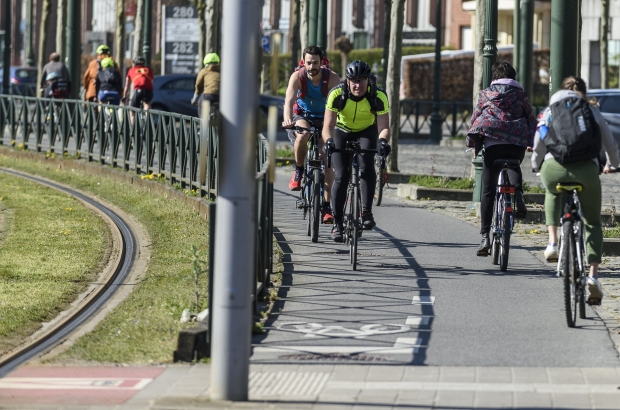- Daily & Weekly newsletters
- Buy & download The Bulletin
- Comment on our articles
Brussels mobility survey shows more people walking and cycling, fewer driving
Brussels residents are walking and cycling more and driving less than they did 10 years ago, according to the latest large-scale study carried out by Brussels Mobility on how the capital gets around.
The survey showed that some 3.3 million journeys were made every day by Brussels people, for a combined distance of 25 million kilometres.
Since the last major survey in 2010, Brussels Mobility notes that walking is the most popular form of transport at 36% of all journeys made in the capital (compared to 32% in 2010 for a main method of travel on an average day).
In parallel, car use has diminished from 38% to 27% and cycling has tripled from 3% to 9%, according to the research carried out between autumn 2021 and 2022, on a sample of 2,685 people.
These figures marry with the relatively small proportion of households owning a car (46%) in the capital, compared to the rest of the country. On the other hand, 47% of Brussels homes possess a bicycle and 11% have at least one electric bike.
The report also reveals that use of public transport diminished slightly from 24% to 22% while train travel remained the same (at 2%). Just 1% of journeys were made by electric scooter and less than 1% of trips were carried out in a lorry, motorbike or taxi.
Turning to why people travel in Brussels, the most common reason after “going home” (38.8%) is “shopping” (15.2%). Meanwhile commuting now makes up only 10.5% of journeys compared to 14% in 2021. This factor was without doubt influenced by the rise in remote working since the Covid-19 pandemic dominated the capital in 2020 and 2021.
While the average distance travelled in a single journey is 7.7km in Belgium, it is only 3.3km in Brussels. Moreover, 45% of trips are shorter than or equal to 2km – where walking is most used (85% for distances less than 1km and 42% for trips between 1km and 2km).
The bicycle is mainly employed for distances between 1km and 5km. Public transport is most common for journeys between 2km and 25km. The train is mainly taken for travel of more than 25km.
As for car journeys, 50% are still made on journeys less than or equal to 5km, even when cycling organisations such as Pro Vélo and the Gracq (an organisation for daily cyclists) say that cycling is quicker. This journey category represents the most potential for change to more active means of transport (walking, cycling or public transport), the study makes clear.
Meanwhile, with Brussels imposing a 30km/h speed limit throughout the region from January 2021 and installing 40km of cycle paths during Covid, along with the increase in electric and family bikes, Brussels mobility minister Elke Van den Brandt (Groen) noted last year that bicycle trips have doubled in 2020 and 2021 alone.




















Comments
Even if the survey were to have been conducted in an unbiased fashion, it does not take into account that the biggest factor by far of more people walking, taking the bus-metro and even cycling (to work or the S/M) more, is that Brussels and other Belgian cities have been flooded by an influx of non Belgians who are trying to integrate into the economy, but do not have the financial means yet to own a car.
A small percentage of city dwellers are walking and/or cycling more because after being bombarded by hard core anti-car and pro-apocalyptic marketing, have succumbed to the pressure.
Many of them do it because they actually feel virtuous. They feel that they have higher moral standards and higher social responsibility than the rest of us, just because they "struggle" through rain, cold and sweat to do what is "the right thing to do"!
As far as to what the mobility minister claims are the reasons of the alleged doubling of bicycle trip doubling in 2020 and 2021, she better look into completely other reasons and stop trying to GASLIGHT us, that it is due to the 30km/h speed limit or the new cycle paths.
After 70 years of pro-car policy, we are finally getting transport planning that takes other forms of transport into account. And the net result is that people are using alternatives to the car.
We only have to look to the Nethlands to see the benefits of proper design and public policy. There's still room for plenty of cars, but the alternative forms of transport are just as good and often better.